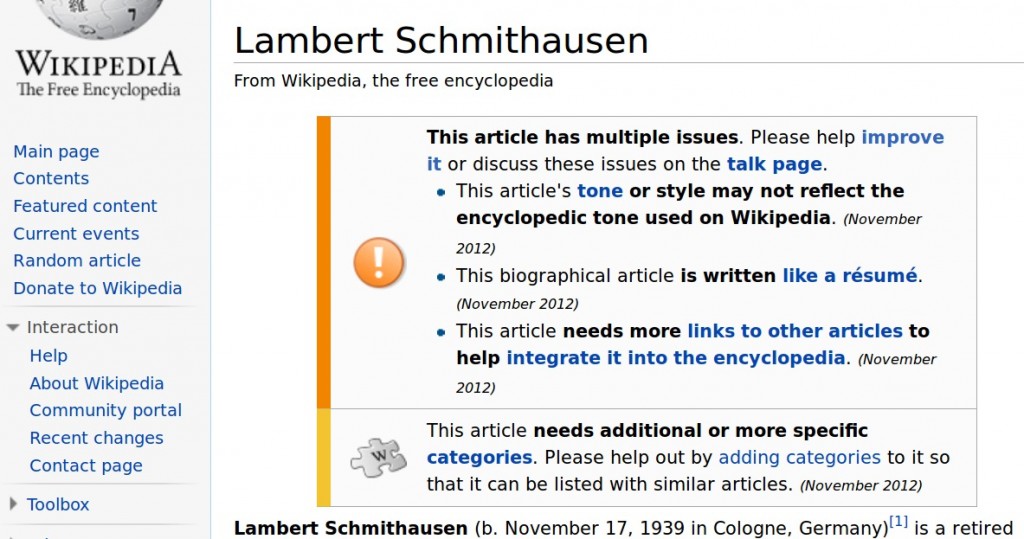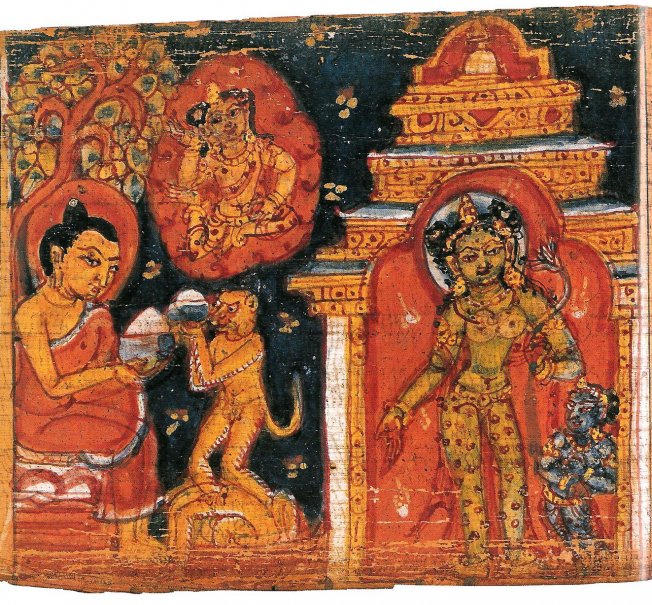Why complain about Wikipedia? Its output speaks for itself:

Why complain about Wikipedia? Its output speaks for itself:

Guess what, theists? Animals have feelings too. That’s what Cambridge scientists are now confident in saying in the wake of the recent Francis Crick Conference. Science and reason are important in a modern society, so it just became that much harder to inflict scripturally sanctioned harm on sentient beings.
This reminds me of a discussion I once had in Germany. Prof. Schmithausen, you were right to think that something was up with theistic contempt for animals. The priests you knew may have been accurate on the detail – animals don’t have souls – but they were wrong on the big picture: they don’t either. Both humans and animals have “homologous subcortical brain networks” and share “primal affective qualia”. Every body hurts; and that suppressed observation was obvious long before it became a hipster anthem.

The Istituto Italiano per l’Africa e l’Oriente (IsIAO), standard bearer of the scholastic brilliance incarnated in Giuseppe Tucci, co-founder of its predecessor institution, is a walking ghost. Its liquidation has already been decreed. But this is a ghost that will not go quietly. Let me satiate the preta by linking to its disembodied voice: isiaoghost.wordpress.com.

A stupid person is a person who caused losses to another person or to a group of persons while himself deriving no gain and even possibly incurring losses.
It doesn’t take much imagination to see that this is directed at the bureaucrats who sacrificed Tucci’s and Gnoli’s legacy upon the unholy altar of economic irrationality. Come to think of it, though, it could equally apply to certain academics. “It is not difficult to understand how […] institutional power enhances the damaging potential of a stupid person,” Prof. Cipolla observes. How true!
(Thanks to A. for the pointer.)
Here’s something you won’t read about in inspiring new books on Varieties of Activist Experience. One recent disclosure suggests that the 2006 street riots which marked the beginning of the end of the Shah monarchy only succeeded because the Royal Nepalese Army ran out of bullets. Apparently, the previous year’s embargo had affected ammunition procurement. The preferred alternative — going through the black market — evidently consumes more time and money.
TNN, ‘W□□□□□□□s throws new light on Nepal king’s surrender’. Times of India, 5 September 2011.
http://timesofindia.indiatimes.com/world/south-asia/W□□□□□□□s-throws-new-light-on-Nepal-kings-surrender/articleshow/9871594.cms
A recent post on H-Buddhism from Dr. Hidenori Sakuma (佐久間秀範) questions the identity of two authors called Asvabhāva: one a commentator on the Mahāyānasutrālaṅkāra, another a commentator on Kambala’s Ālokamālā.
Not wanting to brave H-Buddhism’s shaky moderation — as seen, for example, in the oblivious reposting of Sakuma’s apparently private replies — I responded off-list. My main observation was this: the strong likelihood that the Ālokamālā belongs to a much later era of the Mahāyāna is reflected in the fact that only late authors cite it. Only tantric authors from the tenth century or later, such as Puṇḍarīka and Abhayākaragupta, know about the Ālokamālā. [Edited, 2011/09/23: ninth-century Āryadeva also knows about Kambala, though he refers to a different work.]
Moreover, there is the striking fact that it is cited by name by Śaiva tantric authors who were active in this period. Utpala’s Spandapradīpikā quotes Ālokamālā 141cd and 142, with a couple of variants, and the latter verse appears in Kṣemarāja’s commentary on the Spandakārikās, the Spandanirṇaya.*
The point here is not that this high-level form of Śaivism has such a profound intellectual debt to Buddhism that it must clarify its ideas through direct engagement with Buddhist authors. That is surely old news in this field, if rarely acknowledged in scholarship nowadays. Rather, I want to observe that the Ālokamālā is regarded as a vital tract in this particular period, and no earlier — certainly not in the fifth century, as posited by Chr. Lindtner (and repeated in Potter’s Encyclopedia). This date is probably about half a millennium400 years too early.
It could also be argued, perhaps by someone with more time and resources than myself, that the authors of the Mahāyānasutrālaṅkāra and Ālokamālā in some ways address themselves to different concerns which, it might also be surmised, are characteristic of different eras. The former is conscious of a threat from the Hīnayāna — a phenomenon which it defines with a particular clarity, seemingly lost on many scholars who have fretted about this term — and became a work of almost incontestable authority among Buddhists in India. The Ālokamālā, on the other hand, has other priorities, as did those late tantric authors who found a place for it in their own writings.
* Dyczkowski, The doctrine of vibration, Delhi: Motilal Banarsidass, 1989, p.248, n.31. The verse numbers in the Ālokamālā are supplied by myself.
In recent years, Gregory Schopen has done more than anyone to force a reality check on the West’s part-idealized, part-fantasized conception of the Buddhist bhikṣu. Going boldly into vinaya texts that no Buddhist Studies scholar has read before, Schopen finds that the image of monks as world-renouncing ascetics is far removed from the evidence available in these codes.
Monks in India, certainly those affiliated with the Mūlasarvāstivāda, are seen to be entangled with the world as owners, inheritors, and leasers of property; as active seekers of sponsorship for the fabrication of monasteries and images; and as individuals who very much retain their caste and family identities. Rules for performing ‘meditation’ are comparatively thin; in one passage, those who go to the forest to meditate are denigrated as slightly strange in the head. Indian monastics are, in short, anticipated to be doing the things that Newar Buddhists were long accused of doing as “debasements” of monasticism — activities which, we now know, fall within the normal spectrum of behaviour mandated for the Indian tradition.
The most common objection to Schopen’s work has been that the vinaya itself represents an idealization. But this is his very point: it is remarkable that such prescriptions, laden with provisions for a monk’s immersion in mundane business and social affairs, represent the way things are supposed to be done. Nor should these codes be regarded as something which just sit out there in the realm of the ideal: they are indeed binding, written for the purpose of being binding, on their adherents; and in governing the operation of a saṅgha, their word is final.
A contribution published not long ago in the JPTS, by Peter Skilling,* unearths an extreme example of the monk mired in profanity: a ritual for the bhikṣu to magically reanimate a corpse and dispatch it to kill his foe. In the selected passage from the Vinayavibhaṅga (now preserved only in Tibetan and Chinese) the monk is a necromantic performer and would-be murderer by proxy, in a rite that entails:
As Mr. Skilling observes, with his characteristic good humour and learning (qualities not often found in abundance, much less together, in the Pali Buddhist Studies community), “The primary concern of our text is not the ethics of the matter as such, but what sort of infringements of the monastic rules might be involved” (p.315). If the monk is killed by his own zombie, “the monk incurs a heavy fault (sthūlātyaya)… I do not know whether there are any other cases of posthumous penalties in the monastic codes, but here we have at least one”. That such an outcome was definitely anticipated by the redactors of the vinaya is reflected in the long list of protective techniques provided within the ritual.
Among those defensive options available to the monk is the recitation of a number of “the great apotropaic classics of early Buddhism — notably the Dhvajāgra, the Āṭānāṭīya-, and the Mahāsamāja-sūtras”. Skilling adds, “We still know very little about how the Mahāsūtras were actually used as a set, or to what degree the rituals may have corresponded to [Theravādin rites or] the Rakṣā rituals of Nepal” (p.314). In the literature of Indo-Newar Buddhism there are, in this case as in so many others, more than a few indications to be found regarding the actual practice of such rites.
The Mṛtyuvañcanopadeśa*** of Vāgīśvārakīrti, an Indian master who played an important role in the formation of Newar Buddhism, is a work dealing with the prolongation of one’s life. Although it is concerned primarily with tantric methods such as subtle yoga, it is remarkable that Vāgīśvārakīrti also advocates the recitation of these same Mahāsūtras for the purposes of increasing longevity. This throwback to a much earlier era of monastic practice in a c.11th-century text incidentally marks its author as a monk, or one who at the very least is strongly enculturated in monastic convention.
Later, during the post-Indian period of Newar Buddhism, a number of Sanskrit works were composed on the mollification of life-threatening omens, usually framed as dialogues between Lokeśvara and Tārā. These works offer a kind of meta-protective solution: now one recites either the Pañcarakṣā, or the Mṛtyuvañcanopadeśa itself, in order to avert untimely incidents.
In Skilling’s reference to “the Rakṣā rituals of Nepal”, there is the apparent implication that the rites and literature of the Pañcarakṣā are primarily Nepalese. In fact both the constituent works/deities and the set of five belong to the pan-Indian tradition (the latter, for example, being known to Abhayākaragupta). Again, it would have been nice to see elements regarded as outside the Indian mainstream not being automatically, erroneously, relegated to the Nepalese periphery, where they can be excluded from consideration.
In any case, Peter Skilling’s article adds to the enormous body of scholarship showing that tantric Buddhism has its origins firmly within the monastic community. We do not find a trace of the “siddha” founders proposed by Ronald Davidson in the earliest and best evidence, as exemplified in this extract from the vinaya. Nor should we expect anything different for a tradition that was, right from the start, indeed up to the present, transmitted almost entirely by monks or in connection with monastic institutions, and which makes frequent reference to the practices and ideals of Buddhist monasticism.
* ‘Zombies and Half-Zombies: Mahāsūtras and Other Protective Measures’ The Journal of the Pali Text Society, Vol. XXIX (2007), pp. 313-30.** We should distinguish between the possessing spirit, the vetāla, and the corpse in its possessed/zombified state, as per Somadeva Vasudeva, ‘Concerning vetālas I‘.
*** Johannes Schneider (ed. and tr.), Diss., München, 2006/7? [no details to hand].